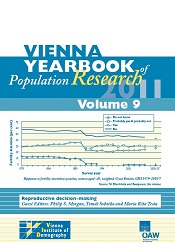 |
Vienna Yearbook of Population Research 2011
|
 |
Verlag der Österreichischen Akademie der Wissenschaften Austrian Academy of Sciences Press
A-1011 Wien, Dr. Ignaz Seipel-Platz 2
Tel. +43-1-515 81/DW 3420, Fax +43-1-515 81/DW 3400 https://verlag.oeaw.ac.at, e-mail: verlag@oeaw.ac.at |
|
||||||||||||||||||||
|
DATUM, UNTERSCHRIFT / DATE, SIGNATURE
BANK AUSTRIA CREDITANSTALT, WIEN (IBAN AT04 1100 0006 2280 0100, BIC BKAUATWW), DEUTSCHE BANK MÜNCHEN (IBAN DE16 7007 0024 0238 8270 00, BIC DEUTDEDBMUC)
|

Vienna Yearbook of Population Research 2011, pp. 157-178, 2012/02/02
doi: 10.1553/populationyearbook2011s157

Using data on 2356 Italian couples from the longitudinal survey on Family and Social Subjects conducted between 2003 and 2007, we examine the relationship between child-timing intentions and subsequent reproductive outcomes. Our hypothesis is that in Italy the lack of agreement between partners has an inhibiting effect on couple’s pregnancy-seeking behaviour because inertia and social norms favour the partner who does not want to have a(nother) child. We find that this holds true only for couples who have already two or more children whereas at lower parities conflicting intentions result in either a middle fertility outcome or childbearing levels similar to those observed for couples who agree on having a child. Women have a greater influence on childbearing decisions than men. The explicit consideration of a partner’s disagreement increases the predictive accuracy of fertility intentions. Our findings strongly support the adoption of a couple-oriented approach in fertility research.
Published Online: 2012/02/02 15:24:22
Object Identifier: 0xc1aa5572 0x002a70fa
Document viewed: 46
Rights: All rights reserved. For questions regarding copyright and copies please contact us by email.
